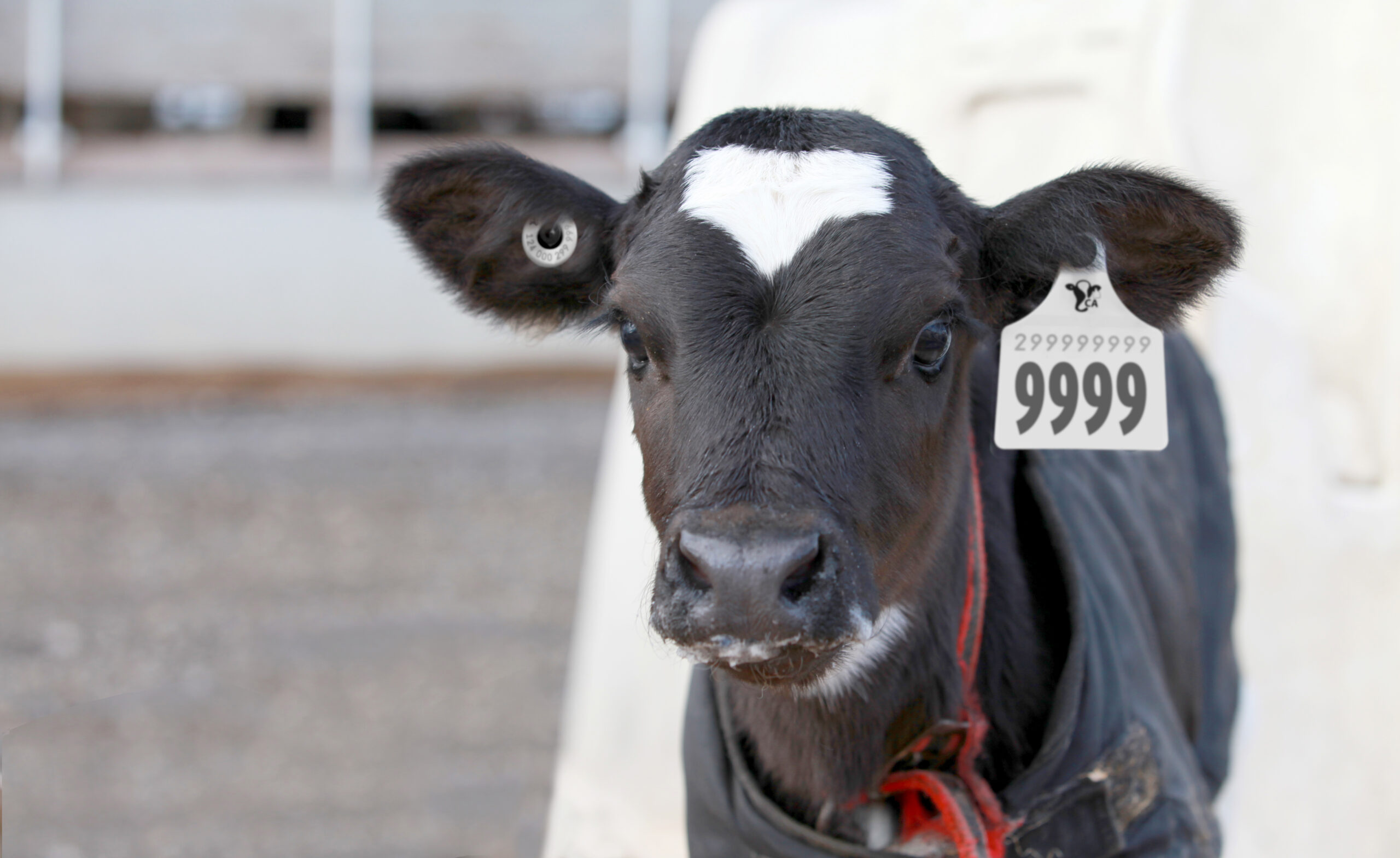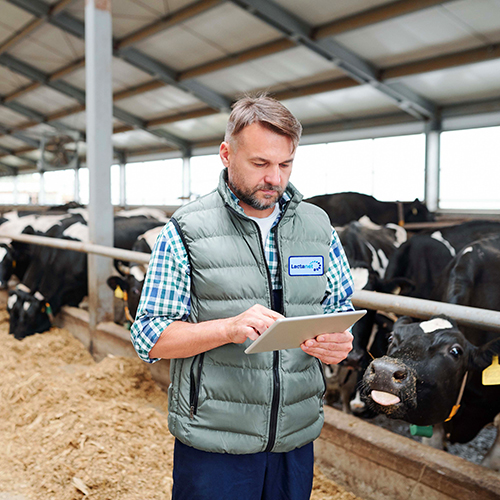Open Industry Session Recap: October 2023
- October 27, 2023
Lactanet’s Open Industry Session (OIS), traditionally held before each Genetic Evaluation Board meeting, is your opportunity to gather the latest information on genetic and genomic evaluations straight from the Genetics team and have your feedback heard. The most recent Open Industry Session covered topics related to type traits with an intermediate optimum value, modernizing the LPI formula, Sexed Semen Fertility ratings, Early Onset Muscle Weakness Syndrome and Lactanet resolutions. See below for a summary of each topic.
Website Display of Evaluations for Type Traits with an Intermediate Optimum Value
Genetic evaluations for linear type traits are calculated using Holstein Canada’s classification program data and are standardized and expressed relative to the genetic base for each breed. Some linear traits are considered to have an intermediate optimum score between 1 and 9 and are published with a letter code instead of a positive or negative sign (e.g., Stature 6T (T = Tall)). When viewing an animal’s Genetic Evaluation Summary page via the Animal Query tool, all linear type traits are displayed together and use blue bars to show the magnitude and direction of the genetic evaluations away from zero as the breed average. The perception of this display is that all bars to the right is always better, but this is not true for traits that have an intermediate optimum value. Lactanet geneticists have developed ideas and considerations around how best to display these traits and improve the understanding of their mid-scoring nature. Two different display options were presented at the OIS, both of which involved grouping the traits with intermediate optimums into a separate table below the “Descriptive” traits section. The Genetic Evaluation Board (GEB) will review these options and their recommendations will be presented to the Lactanet Board of Directors in December for consideration.
Modernizing the LPI Formula
Originally introduced in 1991, the Lifetime Performance Index (LPI) has evolved over the years and the GEB recently asked Lactanet to propose an update or modernization to it. This includes expanding the three current components, namely Production, Durability, and Health & Fertility, and adding a component with sustainability traits, eliminating the mathematical nature of communications, and creating individual sub-indexes that can be used on their own as well as in the LPI. Lactanet is in the very early stages of development including finalizing each sub-index and the scale of expression. Check back for more information on this important initiative!
Sexed Semen Fertility Ratings
Sexed Semen Fertility ratings have been calculated for several years and provided exclusively to AI bull owners for internal purposes, however, Lactanet will soon be publishing them. Sexed Semen Fertility and Semen Fertility ratings are based on insemination records from AI organizations and milk recording and are separated so they do not influence the other rating. If bulls have enough records for conventional or sexed ratings, they can have an official rating for Semen Fertility only, Sexed Semen Fertility only, or both ratings. In the Holstein breed, 802, 258, and 124 bulls are official for Semen Fertility, Sexed Semen Fertility and both ratings, respectively. Keep an eye out for additional articles and an implementation date in early 2024!
Update on Early Onset Muscle Weakness Syndrome in Holsteins
Genomics has paved the way for the identification of multiple genetically undesirable characteristics, including the newly discovered Early Onset Muscle Weakness Syndrome (alternatively known as Calf Recumbency) in Holsteins. This condition presents with varying degrees of severity and impacts the calf’s ability to stand within the first six weeks of life. Based on DNA from affected calves, a gene test was developed, which is now being used by AI companies to identify bulls that are carriers or free of the undesired gene. A large collaborative effort amongst dairy industry stakeholders is still ongoing as the Council on Dairy Cattle Breeding (CDCB) and the Animal Genomics and Improvement Laboratory (AGIL) in the United States are developing a haplotype test that is expected by the end of the year. Once developed, haplotypes will be shared with Lactanet where we expect to display carrier probabilities for Muscle Weakness in early 2024.
Approved Resolutions
Introduced in 2020, the Lactanet Resolutions process allows dairy farmers across Canada to provide direct input in the areas of herd management and genetics. Over the past three years, several resolutions related to genetics services were submitted for consideration by the Lactanet Board of Directors. Several of them have now been implemented including the genomic results of bulls beyond the age of one, publication of parent averages via a new genomics impact tool, and interpretation tables for type traits. Resolutions under development include genetic diversity tools and a haplotype publication pop-up box. For more details, please visit Resolutions website.
For additional information including the presentation handouts, please see our Virtual Open Industry Session page and be sure to join us at the next session in February 2024.
This Open Industry Session covered topics related to body maintenance requirements, methane efficiency, calf health, and leukosis. See below for a summary of each topic.
Genetic Evaluations for Body Maintenance Requirements (BMR)
Evaluations for Body Maintenance Requirements (BMR) will be available in April 2023 for the Holstein breed, providing producers with another tool to reduce feed costs and increase profitability. They are separate from Feed Efficiency evaluations, which are used to select cows that use less feed at the same level of production and body size. Genetic evaluations for BMR consider feed for maintenance requirements as a function of metabolic body weight. This single-step genomic evaluation system with multiple records during the first three lactations will result in Relative Breeding Value’s (RBV) for BMR where a higher RBV represents lower body maintenance requirements (i.e.: a smaller animal). The estimated heritability for BMR is 47%, which ranks it among the most heritable traits offered by Lactanet, and genotyped heifers and young bulls will have an average BMR Reliability over 70%.
Methane Efficiency
Lactanet will also be introducing Methane Efficiency (ME) evaluations for Holsteins in April 2023. The OIS included two presentations related to methane:
Genetic Selection for Methane Efficiency (ME) in Holsteins
Since the October 2022 OIS, Lactanet geneticists have conducted further development on ME evaluations and decided to implement a four-trait model using the three individual production traits as the energy sinks. Methane Efficiency will therefore be genetically independent of milk, fat and protein yields allowing the selection for reduced methane emissions without impacting production levels. ME has an estimated heritability of 13%, has little to no correlation with other traits, and an RBV distribution that generally ranges from 85 to 115, like other functional traits. For each 5-point increase in a sire’s RBV, producers will reduce methane by 3 kg per daughter per year, which translates to a 1.5% reduction in methane emissions and an expected 20-30% reduction by 2050.
Lactanet’s Data Collection Strategy for Sustainability Traits
The second presentation focused on Lactanet’s delivery strategy for Methane Efficiency (ME) and the associated fee structure. Several steps were instrumental to the development of ME evaluations including:
- Two international research projects that collected methane and milk mid-infrared (MIR) spectral data.
- Analysis of methane data by University of Guelph researchers leading to the pivotal result that a cow’s milk MIR data can be used as a good predictor of its methane production.
- Lactanet’s investment in the collection and storage of milk MIR spectral data and the collaboration agreement with Semex Alliance for the development of a single step genomic evaluation system for Methane Efficiency using predicted methane.
- Lactanet’s investment in a long-term data collection strategy including the purchase of feed intake bins and sniffers to collect data for sustainability trait evaluations and update the machine learning algorithm for predicting methane.
Regarding the delivery of ME evaluations for females in Canada, the fee structure will mimic the current strategy applied for Feed Efficiency (FE). However, FE and ME will now be bundled as sustainability traits. As a reminder, these traits will be free and automatically published for females linked to a DHI herd inventory. Canadian-born or owned females not linked to a DHI herd inventory can purchase both traits for $8 and a $2 discount will apply to females linked to a classifying herd.
Keep an eye out for more extension material on BMR and ME as we approach the April release!
Ongoing University of Guelph Research
Participants also had the opportunity to hear from two University of Guelph graduate students, Colin Lynch and Renee Bongers, studying calf health and leukosis, respectively.
Looking Toward Genetic Evaluations to Reduce Calf Disease
Calf diseases are becoming an increasing concern on dairy operations with reported incidence rates between 25-45% for diarrhea and 10-25% for respiratory problems. Calf health records were supplied by Lactanet with over 69,000 Holstein diarrhea and respiratory problem events recorded from 2006 to 2021. Both single and multiple trait analyses were conducted with estimated heritabilities ranging from 3% to 8% and the genetic correlation between diarrhea and respiratory problems was moderate and positive. A clear difference between diseased daughters of the top and bottom 10% sires was also highlighted. Calves born from a bottom 10% sire were 1.5 times more likely to develop diarrhea and 1.4 times more likely to develop respiratory problems compared to daughters born from a top 10% sire. It was recommended the industry use a multiple trait model given the moderate to strong genetic correlation and benefit to heritability estimates, however, standardized collection of specific calf diseases is needed.
Genomic Analysis Aimed at Improving Leukosis Susceptibility
Leukosis is a contagious chronic disease caused by the bovine leukemia virus and can result in decreased production, immunity, and fertility. To identify the prevalence of leukosis in Canada, data provided by Lactanet containing 96,779 cows across 950 herds was analyzed. On average, 87% of herds had at least one positive animal for leukosis. Consistent within-herd prevalence between 2007 and 2021 was seen indicating current management strategies in testing herds have been ineffective at reducing the prevalence of leukosis and genetic solutions may be warranted. The estimated heritability of leukosis resistance is 10% and a favourable correlation was observed with other traits meaning that animals with a higher genetic worth are less susceptible to leukosis. There are also differences between daughters born to high and low genetic merit bulls with daughters born from a bottom 10% sire being 1.3 times more likely to test positive for leukosis than daughters from a top 10% sire. Industry recommendations included increasing the accessibility of proviral load tests and developing genomic evaluations for leukosis resistance.
For additional information including the presentation handouts, please see our Virtual Open Industry Session page and be sure to join us at the next session in October!
This Open Industry Session covered topics related to hoof health, sustainability, breed percentage, and the future publication of cow evaluations. See below for a summary of each OIS topic.
Increased Data and Accuracy of Hoof Health Evaluations
Single-step hoof health evaluations for Holsteins were first introduced in December 2018 using data provided by hoof trimmers. However, the current number of hoof trimmers providing data is still limited. To increase the volume of data in these genetic evaluations, comparable hoof health information from DairyComp can be utilized.
The combined data results in a 61% increase in the number of records and 104% increase in the number of genotyped cows which is useful for single-step evaluations. The increased volume of data from DairyComp also results in a substantial increase in Hoof Health reliability for official sires and genotyped cows. Check back in April 2023 for the implementation!
Sustainability
Sustainability will be the focus of Lactanet’s efforts for the coming years. From a genetic perspective, this includes the current Feed Efficiency evaluations as well as Methane Efficiency planned for April 2023.
Inclusion of Feed Efficiency in LPI and Pro$
Lactanet’s Feed Efficiency evaluations were first introduced in April 2021 for the Holstein breed. As announced earlier this year, this evaluation will include the addition of second lactation data and be added to LPI and Pro$ values starting December 2022. The combined first and second lactation Feed Efficiency will result in a 30% increase in cows with feed intake data and genotypes, providing a better prediction of lifetime efficiency. For proven sires in the genetic base, Feed Efficiency changes will vary with the addition of second lactation data, mostly moving up or down maximally 5 RBV points. Adding Feed Efficiency to the national selection indexes, LPI and Pro$, will also lead to some re-ranking of top animals. Keep an eye out in November for additional details.
Genetic Selection to Reduce Methane Emissions
With climate change becoming a growing global concern, each sector must do its part to reduce its carbon footprint. Dairy Farmers of Canada (DFC) has committed to reaching net-zero greenhouse gas emissions from farm-level production by 2050 and Lactanet’s contribution to these efforts will include genomic evaluation for Methane Efficiency.
Selection for reduced methane emissions, without negatively affecting milk production levels, will provide a permanent and cumulative solution to reduce greenhouse gas emissions.
Lactanet is using milk mid-infrared (MIR) spectroscopy data to predict methane emissions. The single-step genomic evaluation of predicted methane and energy corrected milk will result in Relative Breeding Value (RBV) for Methane Efficiency, allowing producers to select for reduced methane emissions without sacrificing production traits.
Development and Application of “Breed Percentage” Values
Under Canada’s Animal Pedigree Act breed associations designate a Purity Code for each registered animal in accordance with the respective by-laws. Given the evolving by-laws and increased amount of matings across dairy breeds, Lactanet has received requests from industry partners to apply a minimum level of purity for animals
- to be eligible for top lists based on genetic evaluations and
- have a publishable lactation and to be included in herd averages for production.
The Genetic Evaluation Board and Industry Standards Committee recommended that Lactanet develop and implement the calculation of a “Breed Percentage” value to address such requests. Lactanet will continue work to finalize results and rules for each breed prior to consulting with breed associations.
Official implementation will happen on a breed-by-breed basis over the coming months and into 2023.
Proposed Future Publication of Cow Evaluations
The proposed future publication of cow evaluations was initially presented in June 2022 and has been supported by the Lactanet’s Genetic Evaluation Board. Currently, Lactanet has two sets of cow evaluations for production traits official indexes and management indexes, that each serve different purposes.
Lactanet sees two opportunities to change cow evaluations. Firstly, to revise the current criteria for designating cow production evaluations as official. This would include all cows with publishable lactations also having official production indexes and each cow having one production evaluation that is updated monthly.
The second opportunity is the introduction of genomic evaluation services for non-herdbook females in Canada by offering a Canadian genomic evaluation as an alternative to buying one from the United States. These changes are expected to follow the changes to publishable lactations that will take effect in January 2023.











